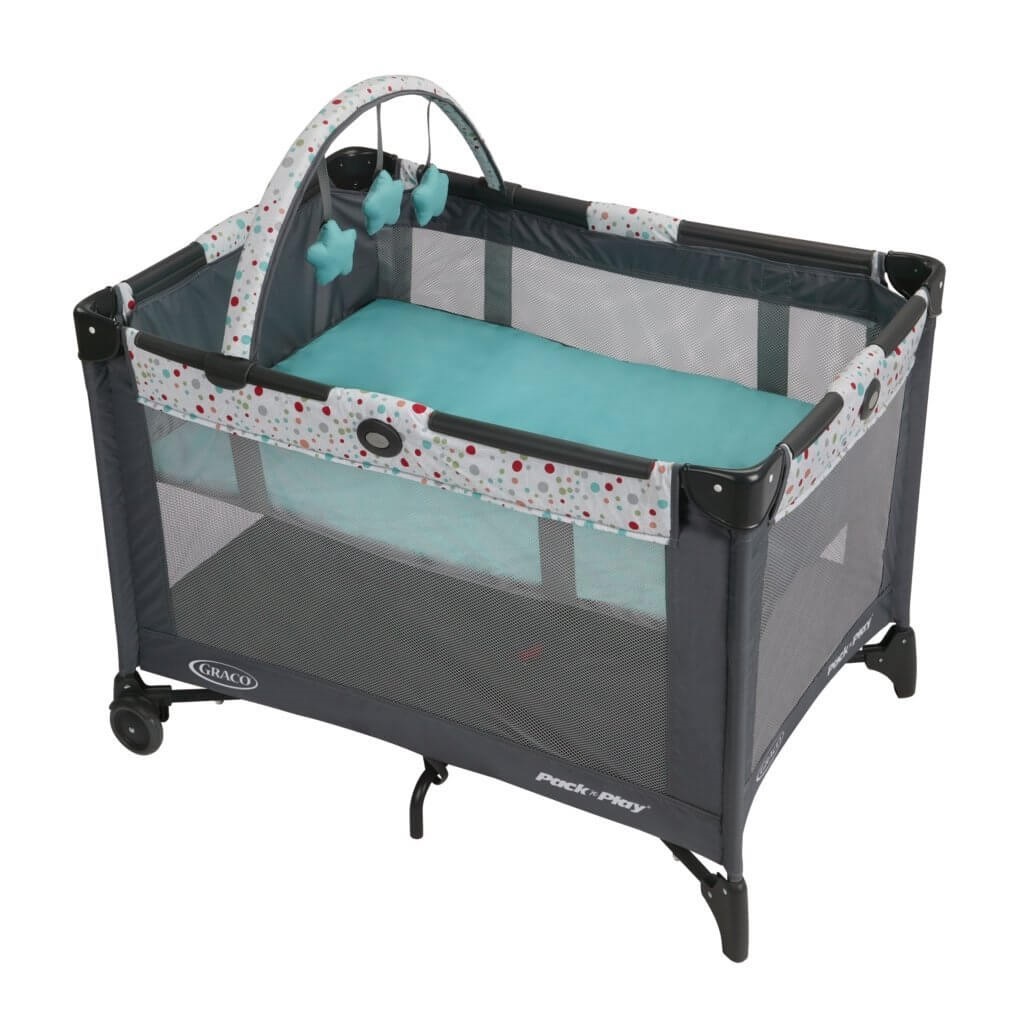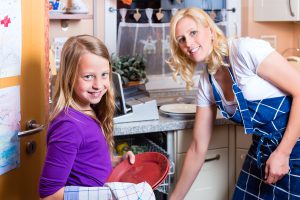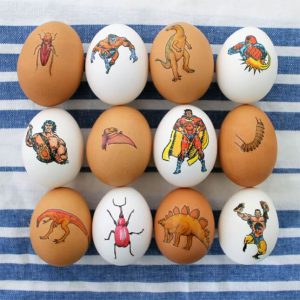
Play Yards

Play Yards
Pediatricians generally consider play yards, such as the Graco Pack ‘n Play, a safe every-night sleep environment for babies. Play yards are subject to new Consumer Product Safety Commission (CPSC) standards approved in 2012 and therefore might be the safest choice. Most play yards feature breathable mesh sides and come with a thin, firm mattress that meets guidelines for preventing SIDS. Remember to use only a fitted sheet designed for use with your play yard. While you may choose a play yard with a removable “napper” or bassinet feature, keep in mind that babies quickly outgrow the napper (usually at 15 pounds or when they begin to roll over), and some nappers have an incline, rather than the level sleep environment recommended for SIDS prevention.
What to avoid:
- Used play yards that seem worn or unsteady. A new play yard made in 2013 or later should be up to the latest federal standards.
- Purchasing a thick, soft mattress in place of the one that comes with the play yard. Pediatricians say that babies do fine sleeping on a firm surface (until they develop a preference for a softer surface — so avoid introducing it). If you do choose to buy a different mattress, be sure it is firm and fits your play yard without any gaps.
- Mobiles or dangling toys that aren’t well attached or that your baby can reach, as these pose a suffocation hazard
Bassinets

Bassinets
Bassinets come in a wide variety of models and styles — from frilly and traditional to sleek and modern. Many new bassinets come with breathable mesh sides, which give parents peace of mind because they allow for good air circulation and visibility for checking on baby during the night. Pediatricians say that bassinets are generally regarded as safe, as long as they come with a firm mattress or sleeping surface. But keep in mind that babies tend to outgrow bassinets long before they reach the maximum weight recommendation (usually between 15 and 30 pounds) because they begin to grow stronger and move around, increasingly coming into contact with the sides of the bassinet.
What to avoid:
- Bassinets with wheels or casters that do not lock, because they can roll or be pushed by a sibling
- Used or heirloom bassinets, which may be worn out, missing parts, or made of materials that don’t meet today’s safety standards. “Always buy new — the maker is required to put the date of manufacture on the product,” Consumer Reports says. “Send in the registration so you can be notified of a recall.”
- Buying a different mattress or fitted sheet that isn’t designed for your particular bassinet or doesn’t fit well
- Moving a collapsible bassinet while your baby is inside it. Portability is part of the appeal of bassinets, but moving them while your baby is inside can cause folding mechanisms to unlatch and collapse.
Cradles

Cradles
Cradles are a classic, compact sleeping space for newborns. But increased awareness of SIDS prevention (which indicates babies should always sleep on their back) has made experts and parents wary of cradles’ rocking motion, which may cause or help infants to roll over on their side or stomach. If you do choose to use a cradle, look for a new model with a firm mattress/pad and a “locking arm” or stopper feature that allows you to prevent the cradle from rocking while your baby is sleeping. Also, keep in mind that your newborn may come to rely on the rocking feature and have a hard time transitioning to a crib when he (quickly) outgrows the cradle. Some of today’s cradles are glider-style (gliding on a level plane rather than rocking in the typical arc motion) or offer “head-to-toe” rocking rather than side-to-side — but a stationary sleep environment is still safest for baby.
What to avoid:
- Used or heirloom cradles, which may not meet modern safety standards
- Plush bumpers or cradle bedding. Cribs with a bare, firm mattress or with a well fitting sheet are best.
- Cradles without the option to lock the wheels/casters and the rocking function. Babies should never be left unattended in a rocking cradle.
Bedside Co-sleepers

Bedside Co-sleepers
Co-sleeping — and bed sharing in particular — is a controversial topic. Because of the risk of SIDS, the AAP advises against using devices that encourage bed sharing or claim to make bed sharing “safe” (such as in-bed co-sleepers). The AAP does not currently have a recommendation (pro or con) regarding bedside co-sleepers. If you’re considering a bedside, bassinet-style co-sleeper, such as the Arm’s Reach Co-Sleeper, drop the rail for nighttime feedings, but remember to raise the side for sleeping and move the sleeper away from your bed to avoid any entrapment or suffocation risk. Most bedside co-sleepers have a weight limit around 20 pounds, and should not be used once your baby can roll on her stomach and push herself up.
What to avoid:
- In-bed co-sleepers or any products that encourage bed sharing
- Bedside co-sleepers without locking wheels or casters
- Mattresses or sheets not designed specifically to fit your co-sleeper
Rocking Sleepers or Other Baby Seats

Rocking Sleepers or Other Baby Seats
Rocking “sleepers,” such as the Fisher-Price Rock ‘n Play, have become extremely popular because of their seemingly magical abilities to soothe babies with rocking, vibration, and/or music. But when it comes to finding a routine sleep environment, it’s best to avoid them. Rocking sleepers, swings, vibrating or bouncy seats, and car seats may be a great place to put baby down for playtime or in the bathroom while you take a shower, but they’re not tested or approved as a sleeping environment for your infant. Newborns lack the neck strength to support their head, so rocking sleepers and any kind of seat on an incline may cause infants’ heads to slump over and compromise their airway. “If an infant falls asleep in a sitting device, he or she should be removed from the product and moved to a crib or other appropriate flat surface as soon as is practical,” the AAP says. Also, remember that your little one may become accustomed to the rocking motion and have trouble transitioning to a crib when she outgrows the seat (usually around 25 pounds). For more long-lasting techniques for soothing baby to sleep, try these tips.
What to avoid:
- Inclined sleepers. The flat Rock ‘n Play Portable Bassinet (with the feet locked for stationary use) is a better choice.
Cribs

Cribs
Does your newborn have to sleep in a bassinet, play yard, or other cozy sleep environment rather than a crib? No. As Consumer Reports points out, cribs are the best long-term investment because babies don’t outgrow them until later in toddlerhood. Cribs are also considered extremely safe because they have been regulated by mandatory federal guidelines for years, and provide the firm, flat sleeping surface that the AAP recommends. But your bedroom may not have enough space, so a mini crib or other small alternative might be your best bet. Mini cribs are subject to the same strict safety standards as full-size cribs, but babies outgrown them sooner (around 35 pounds vs. about 50 pounds for a regular crib).
What to avoid:
- Used cribs (especially drop-side cribs) or any crib that doesn’t meet current safety standards
- Crib bumpers or any other soft, loose bedding
Products and Features to Avoid

Products and Features to Avoid
Also avoid these products, features, and practices:
- Moses baskets, which usually have puffy padding or bumpers that are a suffocation hazard. They’re cute for baby portraits, but not ideal for sleeping.
- Anything with a thick or soft mattress or a gap of more than two fingers between the mattress and the side
- Infant sleep positioners (such as wedges and bolsters). They may make medical claims about their ability to reduce GERD, SIDS, or flat head syndrome, but the FDA has not found sufficient evidence that any of these potential benefits outweighs the risk of suffocation.
- Any crib, bassinet, or other sleep environment that is missing parts or is broken (even if it is presumed to be fixed). Check screws, bolts, and latches periodically.
- Using pillows, cushions, towels, blankets, or other soft materials in the crib or bassinet, even if placed under a sheet. If you must add a layer of soft material, use a towel under the crib mattress itself, but not directly under your baby or the fitted sheet.
Other Tips and Additional Resources

Other Tips and Additional Resources
Consider these additional helpful hints:
JPMA.org’s tips on bassinet and cradle safety
HealthyChildren.org’s tips on suitable sleeping sites for babies
CribsforKids.org’s “Ask the Pediatrician” forum
Consumer Reports’ crib buying guide
Safe Kids Worldwide’s product recall email alert sign-up
- Try to choose products that are certified by the CPSC, ASTM International, and/or the Juvenile Products Manufacturers Association (JPMA).
- If you know you’ll be having a C-section, consider the height of the bassinet. Minimal bending will be best for mom while she’s healing, so you may prefer a higher bassinet.
- If you are concerned about toddler siblings or family pets getting into a bassinet, look into a model with a double canopy or or canopy netting made of a breathable mesh material.
- If you’re using a mattress cover to protect against wetness, it should be thin and fit tightly.
- You may bring your infant into your bed for feeding and comforting, but you should return her to her own space when it is time for you to sleep, according to the AAP.
- Look for organizations in your area that provide low-cost or free cribs or play yards, if your family has financial constraints.
Check out these additional resources:





